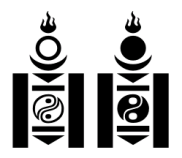Soyombo alphabet
The Soyombo script (Mongolian Соёмбо бичиг, soyombo bichig) is an abugida developed by the Mongolian monk and scholar Bogdo Zanabazar in 1686 to write Mongolian. It can also be used to write Tibetan and Sanskrit.
A special character of the script, the Soyombo symbol, became a national symbol of Mongolia, and has appeared on the national flag since 1921, and on the national coat of arms since 1992, as well as money, stamps, etc.
Creation
The Soyombo script was created as the fourth Mongolian script, only 38 years after the invention of the Clear script.
A legend talks about Zanabazar seeing letter-like signs in the sky one night, which he turned into his new script. The name of the script alludes to this story. It is derived from the Sanskrit word Svayambhu, meaning "created out of itself".
The syllabic system in fact appears to be based on Devanagari script, while the base shape of the letters is derived from the Nepalese Lantsa script (rajana). Details of individual characters resemble traditional Mongolian script and the Orkhon script. It is unclear whether Zanabazar designed the Soyombo symbol himself, or if it had existed beforehand.
Use
The eastern Mongols used the script primarily as a ceremonial and decorative script. Zanabazar had created it for the translation of Buddhist texts from Sanskrit or Tibetan, and both he and his students used it extensively for that purpose.
As it was much too complicated to be adopted as an everyday script, its use is practically nonexistent today. Aside from historical texts, it can usually be found in temple inscriptions. It also has some relevance to linguistic research, because it reflects certain developments in the Mongolian language, such as that of long vowels.
Form
The Soyombo script was the first Mongolian script to be written horizontally from left to right, in contrast to earlier scripts that had been written vertically. As in the Tibetan and Devanagari scripts, the signs are suspended below a horizontal line, giving each line of text a visible "backbone".
The two variations of the Soyombo symbol are used as special characters to mark the start and end of a text. Two of its elements (the upper triangle and the right vertical bar) form the angular base frame for the other characters.
Within this frame, the syllables are composed of one to three elements. The first consonant is placed high within the angle. The vowel is given by a mark above the frame, except for u and ü which are marked in the low center. A second consonant is specified by a small mark, appended to the inside of the vertical bar, pushing any u or ü mark to the left side. A short oblique hook at the bottom of the vertical bar marks a long vowel. There is also a curved or jagged mark to the right of the vertical bar for the two diphthongs.
Alphabet
The first character of the alphabet represents a syllable starting with a short a. Syllables starting with other vowels are constructed by adding a vowel mark to the same base character. All remaining base characters represent syllables starting with a consonant. A starting consonant without a vowel mark implies a following a.
In theory, 20 consonants and 14 vowels would result in almost 4000 combinations, but not all of those actually occur in Mongolian. There are additional base characters and marks for writing Tibetan or Sanskrit.
Apart from the Soyombo symbol, the only punctuation mark is a full stop, represented by a vertical bar. In inscriptions, words are often separated by a dot at the height of the upper triangle.
Unicode
As of Unicode 6.0, the Soyombo script has not yet been encoded. It is tentatively allocated to the Supplementary Multilingual Plane. A preliminary proposal to encode Soyombo has submitted by Anshuman Pandey to the Unicode Technical Committee.
The Menksoft IMEs provide alternative input methods.


